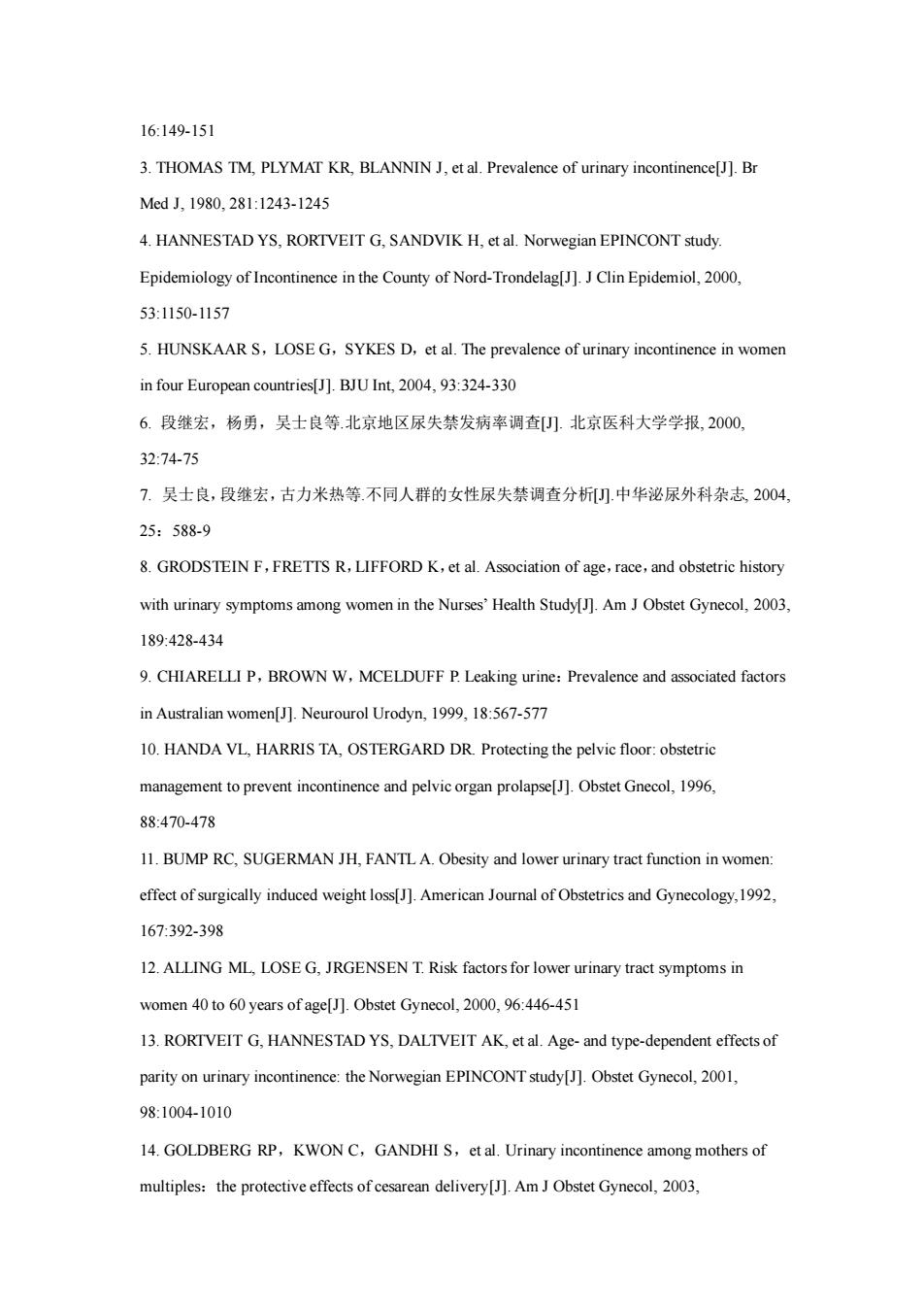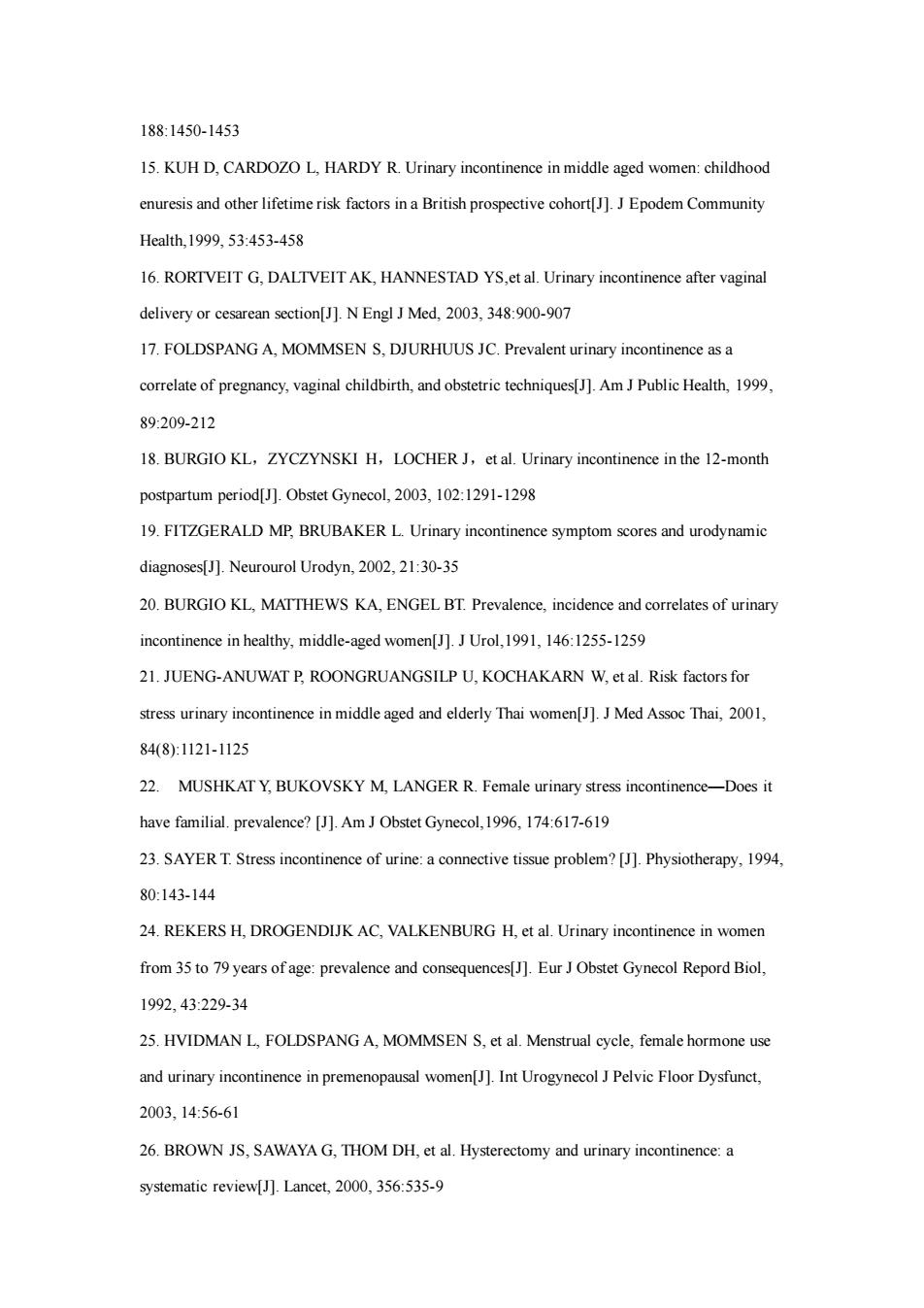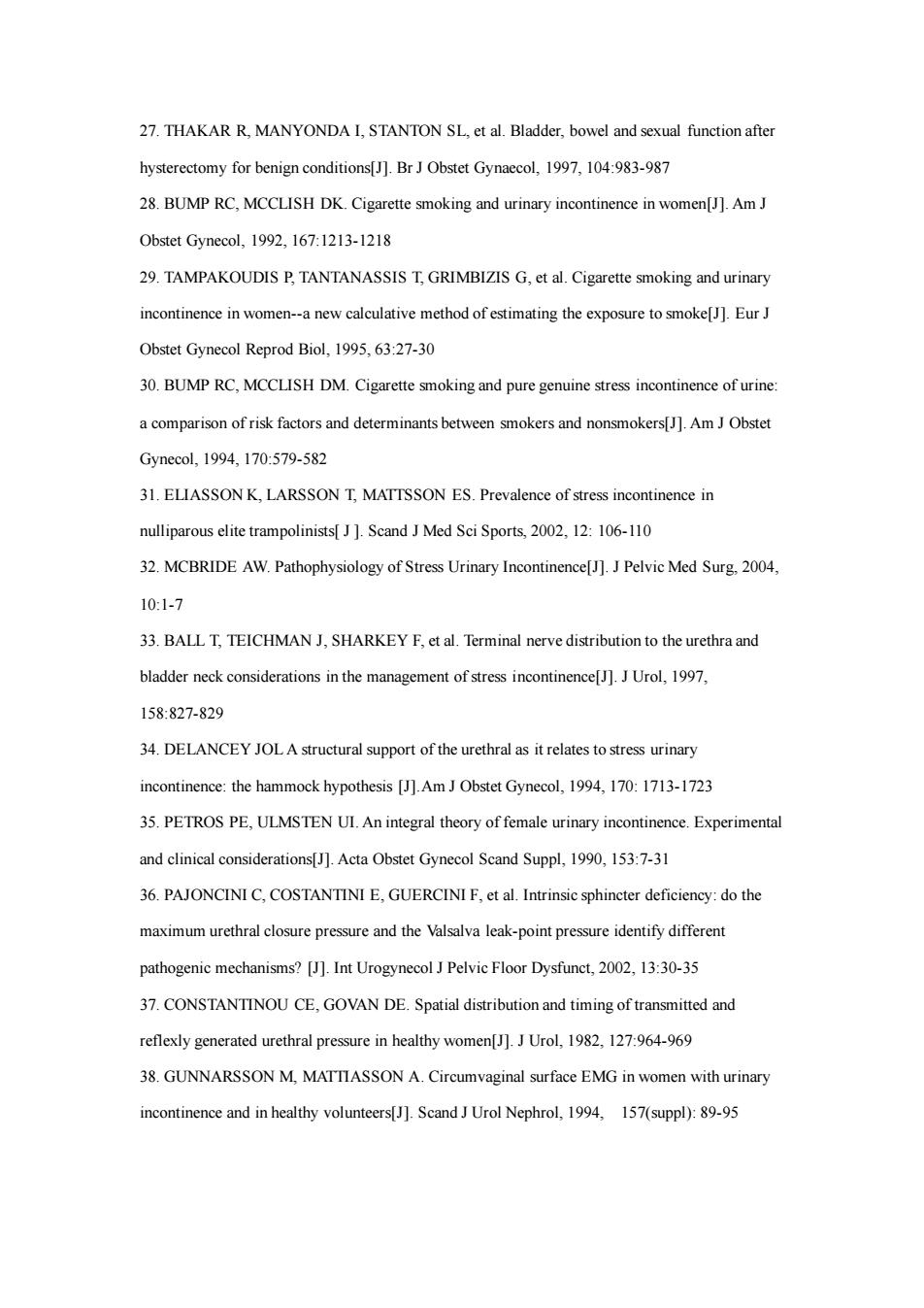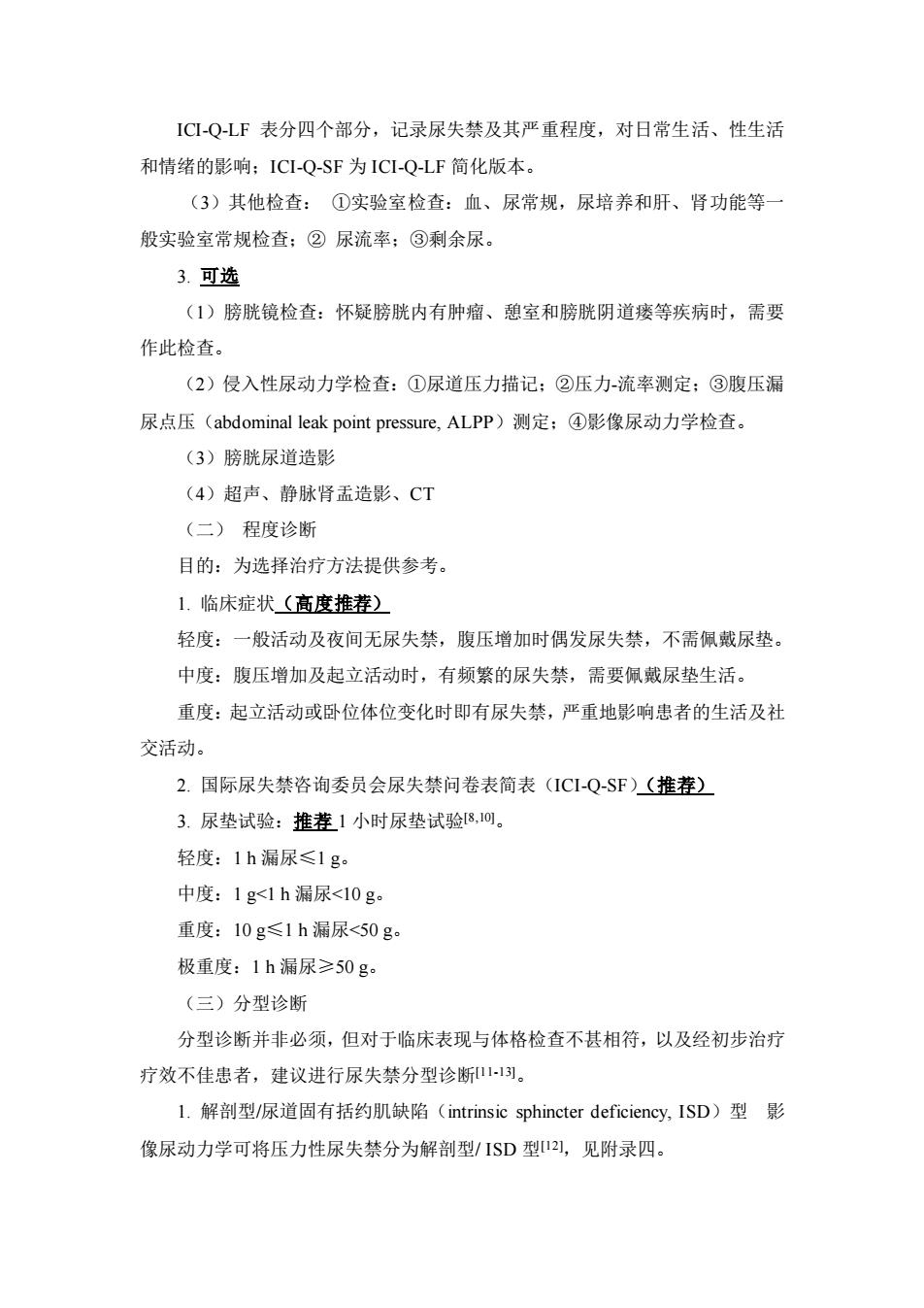
16:149-151 3.THOMAS TM,PLYMAT KR,BLANNIN J,et al.Prevalence of urinary incontinence[J].Br MedJ,1980,281:1243-1245 4.HANNESTAD YS,RORTVEIT G.SANDVIK H,et al.Norwegian EPINCONT study. Epidemiology of Incontinence in the County of Nord-Trondelag[J]JClin Epidemiol,2000, 53:1150-1157 5.HUNSKAAR S,LOSEG,SYKES D,et al.The prevalence of urinary incontinence in womer in four European countries[].BJU Int,4,93:324-330 6.段继宏,杨勇,吴士良等北京地区尿失禁发病率调查.北京医科大学学报,2000, 32:74-75 7.吴士良,段继宏,古力米热等不同人群的女性尿失禁调查分)中华泌尿外科染志2004 25:588-9 8.GRODSTEIN F,FRETTS R,LIFFORD K,et al.Association of age,race,and obstetric history with urinary symptoms among women in the NursesHealth Study AmJObstet Gynecol,003 189:428-434 9.CHIARELLI P,BROWN W,MCELDUFF P Leaking urine:Prevalence and associated factors in Australian women[J].Neurourol Urodyn,1999,18:567-577 10.HANDA VL HARRISTA,OSTERGARD DR Protecting the pelvic floor obstetri management to prevent incontinence and pelvic organ prolapse[J]Obstet Gnecol,1996. 88470-478 11.BUMP RC.SUGERMAN JH.FANTLA.Obesity and lower urinary tract function in women effect of surgically induced weight loss American Joural of Obstetrics and Gynecology,1992 167:392-398 12.ALLING ML LOSEG.JRGENSEN T.Risk factorsfor lower urinary tract symptoms in women 40to60years of age[J]Obstet Gynecol,000,:446-451 13.RORTVEITG,HANNESTAD YS.DALTVEIT AK,etal.Age-and type-dependent effects of parity on urinary incontinence:the Norwegian EPINCONT study[J].Obstet Gynecol,2001, 98:1004-1010 14.GOLDBERG RP,KWON C,GANDHIS,et al.Urinary incontinence among mothers of multiples:the protectiveeffects of cesarean delivery[J].AmObstet Gynecol,2003
16:149-151 3. THOMAS TM, PLYMAT KR, BLANNIN J, et al. Prevalence of urinary incontinence[J]. Br Med J, 1980, 281:1243-1245 4. HANNESTAD YS, RORTVEIT G, SANDVIK H, et al. Norwegian EPINCONT study. Epidemiology of Incontinence in the County of Nord-Trondelag[J]. J Clin Epidemiol, 2000, 53:1150-1157 5. HUNSKAAR S,LOSE G,SYKES D,et al. The prevalence of urinary incontinence in women in four European countries[J]. BJU Int, 2004, 93:324-330 6. 段继宏,杨勇,吴士良等.北京地区尿失禁发病率调查[J]. 北京医科大学学报, 2000, 32:74-75 7. 吴士良,段继宏,古力米热等.不同人群的女性尿失禁调查分析[J].中华泌尿外科杂志, 2004, 25:588-9 8. GRODSTEIN F,FRETTS R,LIFFORD K,et al. Association of age,race,and obstetric history with urinary symptoms among women in the Nurses’ Health Study[J]. Am J Obstet Gynecol, 2003, 189:428-434 9. CHIARELLI P,BROWN W,MCELDUFF P. Leaking urine:Prevalence and associated factors in Australian women[J]. Neurourol Urodyn, 1999, 18:567-577 10. HANDA VL, HARRIS TA, OSTERGARD DR. Protecting the pelvic floor: obstetric management to prevent incontinence and pelvic organ prolapse[J]. Obstet Gnecol, 1996, 88:470-478 11. BUMP RC, SUGERMAN JH, FANTL A. Obesity and lower urinary tract function in women: effect of surgically induced weight loss[J]. American Journal of Obstetrics and Gynecology,1992, 167:392-398 12. ALLING ML, LOSE G, JRGENSEN T. Risk factors for lower urinary tract symptoms in women 40 to 60 years of age[J]. Obstet Gynecol, 2000, 96:446-451 13. RORTVEIT G, HANNESTAD YS, DALTVEIT AK, et al. Age- and type-dependent effects of parity on urinary incontinence: the Norwegian EPINCONT study[J]. Obstet Gynecol, 2001, 98:1004-1010 14. GOLDBERG RP,KWON C,GANDHI S,et al. Urinary incontinence among mothers of multiples:the protective effects of cesarean delivery[J]. Am J Obstet Gynecol, 2003

188:1450-1453 15.KUH D,CARDOZO L HARDY R.Urinary incontinence in middle aged women:childhood enuresis and other lifetime risk factors ina British prospective cohortJ JEpodem Community Health.1999,53:453-458 16.RORTVEIT G,DALTVEITAK,HANNESTAD YS,et al.Urinary incontinence after vaginal delivery or cesarean section[J].NEngl J Med,2003.348:900-907 17.FOLDSPANGA,MOMMSEN S,DJURHUUS JC.Prevalent urinary incontinence asa correlate of pregnancy,vaginal childbirth,and obstetric Health,1999. 89:209-212 18.BURGIO KL,ZYCZYNSKI H,LOCHER J,et al.Urinary incontinence in the 12-month postpartum period[J].Obstet Gynecol,003,102:1291-129 19.FITZGERALD MP BRUBAKERL Urinary incontinence symptom scores and urodynamic diagnoses[J].Neurourol Urodyn,2002,21:30-35 20.BURGIO KL MATTHEWS KA.ENGEL BT.Prevalence,incidence and correlates of urinary incontinence in healthy,middle-aged women[]Urol,1,146:1255-1259 21.JUENG-ANUWAT P.ROONGRUANGSILP U,KOCHAKARN W,et al.Risk factors for stress urinary incontinence in middle aged and elderly Thai women[J].J Med Assoc Thai,2001. 848):1121-1125 22.MUSHKAT Y,BUKOVSKY M,LANGER R.Female urinary stress incontinence-Does it have familial.prevalence?[J].Am J Obstet Gynecol,1996,174:617-619 23.SAYERT Stress incontinence of urine:a conective tissue problem?[].Physiotherapy,1994. 80:143-144 24.REKERS H,DROGENDIJK AC,VALKENBURG H,et al.Urinary incontinence in women from35to79years ofage:prevalence and consequences[J].EurJObstet Gynecol Repord Biol, 1992,43:229-34 25.HVIDMAN L FOLDSPANGA,MOMMSEN S,et al.Menstrual cycle,female hormone use and urinary incontinence in premenopausal women[J].Int Urogynecol Pelvic Floor Dysfunct, 2003,14:56-61 26.BROWN JS,SAWAYA G.THOM DH,et al.Hysterectomy and urinary incontinence:a systematic review[J].Lancet,2000,356:535-9
188:1450-1453 15. KUH D, CARDOZO L, HARDY R. Urinary incontinence in middle aged women: childhood enuresis and other lifetime risk factors in a British prospective cohort[J]. J Epodem Community Health,1999, 53:453-458 16. RORTVEIT G, DALTVEIT AK, HANNESTAD YS,et al. Urinary incontinence after vaginal delivery or cesarean section[J]. N Engl J Med, 2003, 348:900-907 17. FOLDSPANG A, MOMMSEN S, DJURHUUS JC. Prevalent urinary incontinence as a correlate of pregnancy, vaginal childbirth, and obstetric techniques[J]. Am J Public Health, 1999, 89:209-212 18. BURGIO KL,ZYCZYNSKI H,LOCHER J,et al. Urinary incontinence in the 12-month postpartum period[J]. Obstet Gynecol, 2003, 102:1291-1298 19. FITZGERALD MP, BRUBAKER L. Urinary incontinence symptom scores and urodynamic diagnoses[J]. Neurourol Urodyn, 2002, 21:30-35 20. BURGIO KL, MATTHEWS KA, ENGEL BT. Prevalence, incidence and correlates of urinary incontinence in healthy, middle-aged women[J]. J Urol,1991, 146:1255-1259 21. JUENG-ANUWAT P, ROONGRUANGSILP U, KOCHAKARN W, et al. Risk factors for stress urinary incontinence in middle aged and elderly Thai women[J]. J Med Assoc Thai, 2001, 84(8):1121-1125 22. MUSHKAT Y, BUKOVSKY M, LANGER R. Female urinary stress incontinence—Does it have familial. prevalence? [J]. Am J Obstet Gynecol,1996, 174:617-619 23. SAYER T. Stress incontinence of urine: a connective tissue problem? [J]. Physiotherapy, 1994, 80:143-144 24. REKERS H, DROGENDIJK AC, VALKENBURG H, et al. Urinary incontinence in women from 35 to 79 years of age: prevalence and consequences[J]. Eur J Obstet Gynecol Repord Biol, 1992, 43:229-34 25. HVIDMAN L, FOLDSPANG A, MOMMSEN S, et al. Menstrual cycle, female hormone use and urinary incontinence in premenopausal women[J]. Int Urogynecol J Pelvic Floor Dysfunct, 2003, 14:56-61 26. BROWN JS, SAWAYA G, THOM DH, et al. Hysterectomy and urinary incontinence: a systematic review[J]. Lancet, 2000, 356:535-9

27.THAKAR R,MANYONDA I,STANTON SL,et al.Bladder,bowel and sexual function after hysterectomy for benign conditions[J].Br JObstet Gynaecol,1997,104:983-987 28.BUMP RC.MCCLISH DK.Cigarette smoking and urinary incontinence in women[J].AmJ Obstet Gynecol,192.167:1213-1218 29.TAMPAKOUDIS P TANTANASSIS T,GRIMBIZIS G,et al.Cigarette smoking and urinary incontinence in women--a new calculative method of estimating the exposure to smoke[J].Eur J Obstet Gynecol Reprod Biol6327-30 30.BUMP RC,MCCLISH DM.Cigarette smoking and pure genuine stress incontinence of urine a comparison of risk factors and determinants between smokers and nonsmokers.AmJObstet Gynecol,.1994,170:579-582 31.ELASSONK,LARSSON T MATTSSON ES.Prevalence of stress incontinence in nulliparous elite trampolinists[J].Secand JMed SciSports,00,12:106-110 32.MCBRIDE AW.Pathophysiology of Stress Urinary Incontinence[J].J Pelvic Med Surg.2004. 101-7 33.BALLT,TEICHMAN J,SHARKEY F,etal.Terminal nerve distribution to the urethra and bladder neck considerations in the management of stress incontinenceJUrol,1997, 158827-829 34.DELANCEY JOLA structural suppor of the urethral as it relates tostress urinary incontinence:the hammock hypothesis [J]Am JObstet Gynecol,1994,170:1713-1723 35.PETROS PE,ULMSTEN UI.An integral theory of female urinary incontinence.Experimental and clinical considerations[]Acta Obstet Gynecol Seand Suppl,99.153:7-31 36.PAJONCINIC,COSTANTINI E,GUERCINIF,et al.Intrinsic sphincter deficiency:do the maximum urethral closure pressure and the Valsalva leak-point pressure identify different pathogenic mechanisms?[]Int Urogynecol Pelvic Floor Dysfunct,00,13:0-35 37.CONSTANTINOU CE.GOVAN DE.Spatial distribution and timing of transmitted and reflexly generated urethral pressure in healthy women[]Urol,1982,127964-969 38.GUNNARSSON M,MATTIASSON A.Circumvaginal surface EMG in women with urinary incontinence and in healthy volunteers[J].Scand JUrol Nephrol,1994,157(suppl):89-95
27. THAKAR R, MANYONDA I, STANTON SL, et al. Bladder, bowel and sexual function after hysterectomy for benign conditions[J]. Br J Obstet Gynaecol, 1997, 104:983-987 28. BUMP RC, MCCLISH DK. Cigarette smoking and urinary incontinence in women[J]. Am J Obstet Gynecol, 1992, 167:1213-1218 29. TAMPAKOUDIS P, TANTANASSIS T, GRIMBIZIS G, et al. Cigarette smoking and urinary incontinence in women--a new calculative method of estimating the exposure to smoke[J]. Eur J Obstet Gynecol Reprod Biol, 1995, 63:27-30 30. BUMP RC, MCCLISH DM. Cigarette smoking and pure genuine stress incontinence of urine: a comparison of risk factors and determinants between smokers and nonsmokers[J]. Am J Obstet Gynecol, 1994, 170:579-582 31. ELIASSON K, LARSSON T, MATTSSON ES. Prevalence of stress incontinence in nulliparous elite trampolinists[ J ]. Scand J Med Sci Sports, 2002, 12: 106-110 32. MCBRIDE AW. Pathophysiology of Stress Urinary Incontinence[J]. J Pelvic Med Surg, 2004, 10:1-7 33. BALL T, TEICHMAN J, SHARKEY F, et al. Terminal nerve distribution to the urethra and bladder neck considerations in the management of stress incontinence[J]. J Urol, 1997, 158:827-829 34. DELANCEY JOL A structural support of the urethral as it relates to stress urinary incontinence: the hammock hypothesis [J].Am J Obstet Gynecol, 1994, 170: 1713-1723 35. PETROS PE, ULMSTEN UI. An integral theory of female urinary incontinence. Experimental and clinical considerations[J]. Acta Obstet Gynecol Scand Suppl, 1990, 153:7-31 36. PAJONCINI C, COSTANTINI E, GUERCINI F, et al. Intrinsic sphincter deficiency: do the maximum urethral closure pressure and the Valsalva leak-point pressure identify different pathogenic mechanisms? [J]. Int Urogynecol J Pelvic Floor Dysfunct, 2002, 13:30-35 37. CONSTANTINOU CE, GOVAN DE. Spatial distribution and timing of transmitted and reflexly generated urethral pressure in healthy women[J]. J Urol, 1982, 127:964-969 38. GUNNARSSON M, MATTIASSON A. Circumvaginal surface EMG in women with urinary incontinence and in healthy volunteers[J]. Scand J Urol Nephrol, 1994, 157(suppl): 89-95

二、诊断 压力性尿失禁诊断主要依据主观症状和客观检查,并需除外其他疾病。本病 的诊断步骤应包括确定诊断(高度推)、程度诊断(推)、分型诊断(可选) 及合并疾病诊断(高度推荐)。 (一)确定诊断 目的:确定有无压力性尿失禁。 主要依据:病史和体格检查6。 1.高度推差 (1)病史 1)全身情况:一般情况、智力、认知和是否发热等。 2)压力性尿失禁症状:大笑、咳嗽、喷嚏或行走等各种程度腹压增加时尿 液是否漏出:停止加压动作时尿流是否随即终止。 3)泌尿系其他症状:血尿、排尿困难、尿路刺激症状或下腹或腰部不适等。 4)其他病史:既往病史、月经生育史、生活习惯、活动能力、并发疾病和 使用药物等。 (2)体格检查 1)一般状态:生命体征、步态及身体活动能力、精细程度及对事物的认知 能力。 2)全身体检:神经系统检查包括下肢肌力、会阴部感觉、肛门括约肌张力 及病理征等:腹部检查注意有无尿潴留体征。 3)专科检查:外生殖器有无盆腔脏器膨出及程度:外阴部有无长期感染 所引起的异味、皮疹;双合诊了解子宫水平、大小和盆底肌收缩力等:肛门指诊 检查括约肌肌力及有无直肠膨出。 4)其他特殊检查。 压力诱发试验8个,详见附录一。 2.推挂 (1)排尿日记:连续记录72小时排尿情况,包括每次排尿时间、尿量、 饮水时间、饮水量、伴随症状和尿失禁时间等,见附录二。 (2)国际尿失禁咨询委员会尿失禁问卷表简表(ICI-Q-SF)例。见附录三
二、 诊断 压力性尿失禁诊断主要依据主观症状和客观检查,并需除外其他疾病。本病 的诊断步骤应包括确定诊断(高度推荐)、程度诊断(推荐)、分型诊断(可选) 及合并疾病诊断(高度推荐)。 (一)确定诊断 目的:确定有无压力性尿失禁。 主要依据:病史和体格检查[1-6]。 1. 高度推荐 (1)病史 1)全身情况:一般情况、智力、认知和是否发热等。 2)压力性尿失禁症状:大笑、咳嗽、喷嚏或行走等各种程度腹压增加时尿 液是否漏出;停止加压动作时尿流是否随即终止。 3)泌尿系其他症状:血尿、排尿困难、尿路刺激症状或下腹或腰部不适等。 4)其他病史:既往病史、月经生育史、生活习惯、活动能力、并发疾病和 使用药物等。 (2)体格检查 1)一般状态:生命体征、步态及身体活动能力、精细程度及对事物的认知 能力。 2)全身体检:神经系统检查包括下肢肌力、会阴部感觉、肛门括约肌张力 及病理征等;腹部检查注意有无尿潴留体征。 3)专科检查:外生殖器有无盆腔脏器膨出及程度[7];外阴部有无长期感染 所引起的异味、皮疹;双合诊了解子宫水平、大小和盆底肌收缩力等;肛门指诊 检查括约肌肌力及有无直肠膨出。 4)其他特殊检查。 压力诱发试验[8],详见附录一。 2. 推荐 (1)排尿日记:连续记录 72 小时排尿情况,包括每次排尿时间、尿量、 饮水时间、饮水量、伴随症状和尿失禁时间等,见附录二。 (2)国际尿失禁咨询委员会尿失禁问卷表简表(ICI-Q-SF)[9]。见附录三

IC1-Q-LF表分四个部分,记录尿失禁及其严重程度,对日常生活、性生活 和情绪的影响:ICI-Q-SF为ICI-QLF简化版本。 (3)其他检查:①实验室检查:血、尿常规,尿培养和肝、肾功能等一 般实验室常规检查:②尿流率;③剩余尿 3.可选 (1)膀胱镜检查:怀疑膀胱内有肿瘤、憩室和膀胱阴道瘘等疾病时,需要 作此检查。 (2)侵入性尿动力学检查:①尿道压力描记:②压力-流率测定:③腹压漏 尿点压(abdominal leak point pressure,.ALPp)测定:④影像尿动力学检查。 (3)膀胱尿道造影 (4)超声、静脉肾盂造影、CT (二)程度诊断 目的:为选择治疗方法提供参考。 1.临床症状(高度推荐) 轻度:一般活动及夜间无尿失禁,腹压增加时偶发尿失禁,不需佩戴尿垫 中度:腹压增加及起立活动时,有频繁的尿失禁,需要佩戴尿垫生活。 重度:起立活动或卧位体位变化时即有尿失禁,严重地影响患者的生活及社 交活动。 2.国际尿失禁咨询委员会尿失禁问卷表简表(IC1-Q-SF)(推荐) 3.尿垫试验:推差1小时尿垫试验8,0。 轻度:1h漏尿≤1g 中度:1g<1h漏尿<10g 重度:10g≤1h漏尿<50g 极重度:1h漏尿≥50g。 (三)分型诊断 分型诊断并非必须,但对于临床表现与体格检查不甚相符,以及经初步治疗 疗效不佳患者,建议进行尿失禁分型诊断到。 L.解剖型/尿道固有括约肌缺陷(intrinsic sphincter deficiency,ISD)型影 像尿动力学可将压力性尿失禁分为解剖型/1SD型2),见附录四
ICI-Q-LF 表分四个部分,记录尿失禁及其严重程度,对日常生活、性生活 和情绪的影响;ICI-Q-SF 为 ICI-Q-LF 简化版本。 (3)其他检查: ①实验室检查:血、尿常规,尿培养和肝、肾功能等一 般实验室常规检查;② 尿流率;③剩余尿。 3. 可选 (1)膀胱镜检查:怀疑膀胱内有肿瘤、憩室和膀胱阴道瘘等疾病时,需要 作此检查。 (2)侵入性尿动力学检查:①尿道压力描记;②压力-流率测定;③腹压漏 尿点压(abdominal leak point pressure, ALPP)测定;④影像尿动力学检查。 (3)膀胱尿道造影 (4)超声、静脉肾盂造影、CT (二) 程度诊断 目的:为选择治疗方法提供参考。 1. 临床症状(高度推荐) 轻度:一般活动及夜间无尿失禁,腹压增加时偶发尿失禁,不需佩戴尿垫。 中度:腹压增加及起立活动时,有频繁的尿失禁,需要佩戴尿垫生活。 重度:起立活动或卧位体位变化时即有尿失禁,严重地影响患者的生活及社 交活动。 2. 国际尿失禁咨询委员会尿失禁问卷表简表(ICI-Q-SF)(推荐) 3. 尿垫试验:推荐 1 小时尿垫试验[8,10]。 轻度:1 h 漏尿≤1 g。 中度:1 g<1 h 漏尿<10 g。 重度:10 g≤1 h 漏尿<50 g。 极重度:1 h 漏尿≥50 g。 (三)分型诊断 分型诊断并非必须,但对于临床表现与体格检查不甚相符,以及经初步治疗 疗效不佳患者,建议进行尿失禁分型诊断[11-13]。 1. 解剖型/尿道固有括约肌缺陷(intrinsic sphincter deficiency, ISD)型 影 像尿动力学可将压力性尿失禁分为解剖型/ ISD 型[12],见附录四